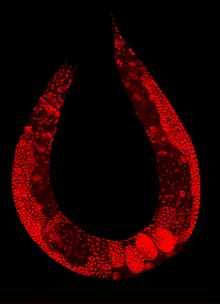Organismong multiselular
Ang artikulong ito ay nangangailangan ng maayos na salin. (walang petsa) |

Ang isang organismong multiselular ay isang organismo na binubuo ng higit sa isang selula at salungat sa organismong uniselular.[1]
Ang lahat ng mga espesye ng mga hayop, mga Embryophyte(halamang panglupain) at karamihan ng fungi ay multiselyular gaya ng maraming mga algae samantalang ang ilang mga organismo ay bahaging uniselyular at bahaging multiselyular gaya ng mga slime mold at mga genus ng amoebae gaya ng Dictyostelium.[2][3]
Ang mga organismong multiselular ay lumilitaw sa maraming paraan halimbawa, sa dibisyon ng selula o sa pagsasama ng maraming mga isang selula.[4][3] Colonial organisms are the result of many identical individuals joining together to form a colony. However, it can often be hard to separate colonial protists from true multicellular organisms, because the two concepts are not distinct; colonial protists have been dubbed "pluricellular" rather than "multicellular".[5][6] Mayroon ring mga multinucleate bagaman ang mga teknikal na organismo na makroskopiko gaya ng xenophyophorea ay umaabot na 20 cm.
Mga sanggunian[baguhin | baguhin ang wikitext]
- ↑ Becker, Wayne M.; et al. (2008). The world of the cell. Pearson Benjamin Cummings. p. 480. ISBN 978-0-321-55418-5.
- ↑ Chimileski, Scott; Kolter, Roberto (2017). Life at the Edge of Sight: A Photographic Exploration of the Microbial World. Harvard University Press. ISBN 9780674975910.
- ↑ 3.0 3.1 Lyons, Nicholas A.; Kolter, Roberto (April 2015). "On the evolution of bacterial multicellularity". Current Opinion in Microbiology. 24: 21–28. doi:10.1016/j.mib.2014.12.007. ISSN 1879-0364. PMC 4380822. PMID 25597443.
- ↑ S. M. Miller (2010). "Volvox, Chlamydomonas, and the evolution of multicellularity". Nature Education. 3 (9): 65.
- ↑ Brian Keith Hall; Benedikt Hallgrímsson; Monroe W. Strickberger (2008). Strickberger's evolution: the integration of genes, organisms and populations (4th pat.). Hall/Hallgrímsson. p. 149. ISBN 978-0-7637-0066-9.
- ↑ Adl, Sina; et al. (October 2005). "The New Higher Level Classification of Eukaryotes with Emphasis on the Taxonomy of Protists". J. Eukaryot. Microbiol. 52 (5): 399–451. doi:10.1111/j.1550-7408.2005.00053.x. PMID 16248873. S2CID 8060916.
